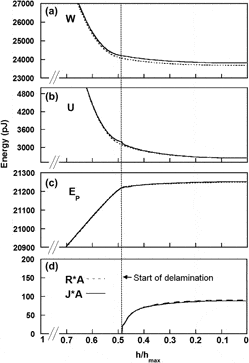Crossref Citations
This article has been cited by the following publications. This list is generated based on data provided by
Crossref.
Lu, Mingyuan
and
Huang, Han
2014.
Determination of the energy release rate in the interfacial delamination of silicon nitride film on gallium arsenide substrate via nanoindentation.
Journal of Materials Research,
Vol. 29,
Issue. 6,
p.
801.
Chen, Jinju
2015.
Thin Films and Coatings.
p.
123.
Framil Carpeño, David
Ohmura, Takahito
Zhang, Ling
Leveneur, Jérôme
Dickinson, Michelle
Seal, Christopher
Kennedy, John
and
Hyland, Margaret
2015.
Nanomechanical and in situ TEM characterization of boron carbide thin films on helium implanted substrates: Delamination, real-time cracking and substrate buckling.
Materials Science and Engineering: A,
Vol. 639,
Issue. ,
p.
54.
Lu, Mingyuan
and
Huang, Han
2015.
Interfacial energy release rates of SiN/GaAs film/substrate systems determined using a cyclic loading dual-indentation method.
Thin Solid Films,
Vol. 589,
Issue. ,
p.
822.
Xie, Hongtao
Mead, James L
Wang, Shiliang
Fatikow, Sergej
and
Huang, Han
2018.
Characterizing the surface forces between two individual nanowires using optical microscopy based nanomanipulation.
Nanotechnology,
Vol. 29,
Issue. 22,
p.
225705.
Liu, Dong
Fabes, Stephen
Li, Bo-Shiuan
Francis, Daniel
Ritchie, Robert O.
and
Kuball, Martin
2019.
Characterization of the Interfacial Toughness in a Novel “GaN-on-Diamond” Material for High-Power RF Devices.
ACS Applied Electronic Materials,
Vol. 1,
Issue. 3,
p.
354.
Fazeli, Sara
and
Khatiboleslam Sadrnezhaad, Sayed
2019.
Molecular dynamics simulation of plastic deformation and interfacial delamination of NiTi/Ag bilayer by cyclic-nanoindentation: Effects of crystallographic orientation of substrate.
Computational Materials Science,
Vol. 168,
Issue. ,
p.
229.
Francis, Daniel
and
Kuball, Martin
2022.
Thermal Management of Gallium Nitride Electronics.
p.
295.
Fazeli, Sara
Brault, Pascal
Caillard, Amaël
Thomann, Anne-Lise
Millon, Eric
Atmane, Soumya
and
Coutanceau, Christophe
2023.
Atomistic insight into the defect-induced tunable plasticity and electronic properties of tetragonal zirconia.
Materials Today Communications,
Vol. 36,
Issue. ,
p.
106731.
Voronin, N. A.
2023.
Determining the Residual Stress in Thin Coatings from Their Flexure after Indentation.
Russian Engineering Research,
Vol. 43,
Issue. 10,
p.
1189.
Voronin, N. A.
2024.
CALCULATION AND EXPERIMENTAL METHOD FOR DETERMINING THE ADHESIVE STRENGTH OF THIN HARD COATINGS.
Spravochnik. Inzhenernyi zhurnal,
p.
56.



